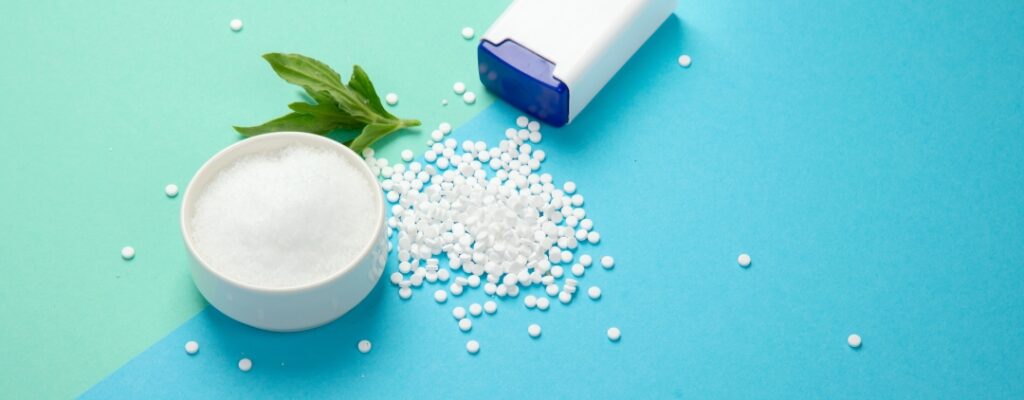Table of contents:
- Fillers: the secret magic ingredient
- Types and examples of fillers
- Are fillers harmful to health?
- How do fillers influence price and quality?
- What fillers are found in organic vegetable stock?
- The better vegetable stock
- Conclusion: What does this mean for you?
Imagine you're standing in the supermarket, surrounded by shelves filled to the brim with delicious-looking products. Your eyes fall on a vegetable broth - organic, of course. You think of vegetables, herbs, maybe a hint of sea salt. But what if we told you that there's more to it than you think? And that these "more" ingredients are a big secret behind the low price of your favourite foods?
This is where fillers come in - those little-known food industry helpers that are hidden in many of the products we consume every day. But what's really behind this term and why do they play such a crucial role in the production of food, including the seemingly simple organic vegetable broth in your shopping trolley?
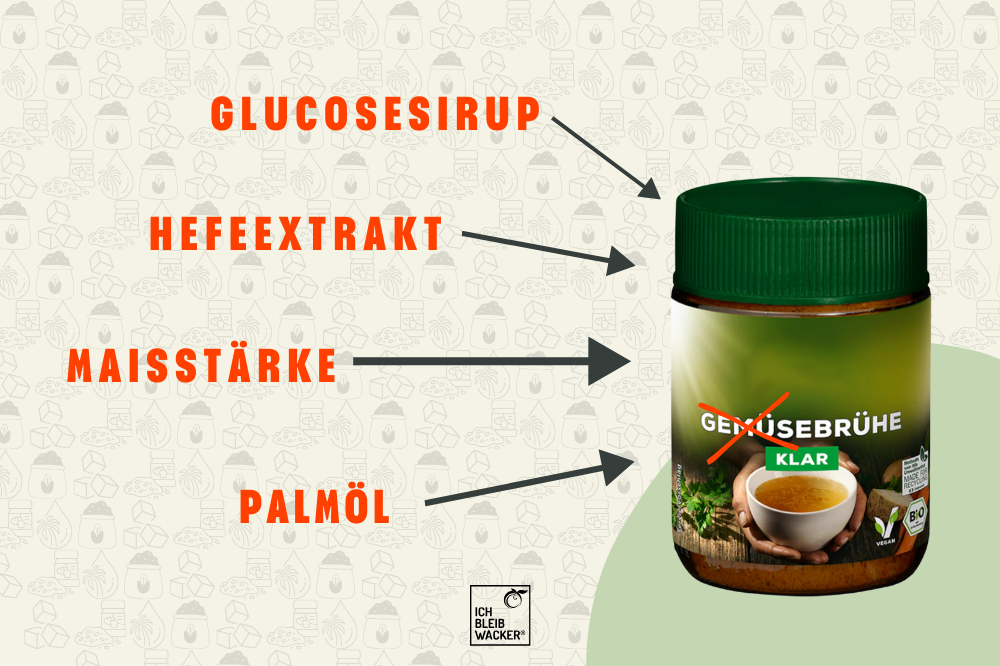
Fillers: the secret magic ingredient
Fillers are considered additives. Fillers are substances that can be added to a product for various reasons. Among other things, they are used to increase volume or improve certain properties such as texture and shelf life without significantly changing the basic character of the product. Fillers come in many forms, from fibre, which can also be beneficial to health, to simple carbohydrates, which offer little to no nutritional value. They can come from a variety of sources, including natural, nature-identical and synthetic materials.
Positive effects:
- Improved texture and consistencyFillers can improve the texture and consistency of food, resulting in a more enjoyable eating experience. For example, they can make baked goods softer or give sauces the right thickness.
- Cost reductionFoods with fillers are often less expensive, which can benefit consumers on a budget without sacrificing quantity or satiety.
- Longer shelf lifeCertain fillers can extend the shelf life of food by acting as a preservative, which means less food waste and ensures the availability of products for longer periods of time.
Negative effects:
- Potential allergic reactionsSome fillers may cause allergic reactions or intolerances in certain people, particularly in products that are not clearly labelled as such.
- Reduced product qualityExcessive use of fillers may lead to a perceived reduction in quality as they may affect the flavour, texture or nutritional value of the final product.
- Nutritionally less valuableSome fillers can dilute the nutritional value of a food by replacing more nutrient-rich ingredients, resulting in lower levels of vitamins, minerals and other important nutrients.
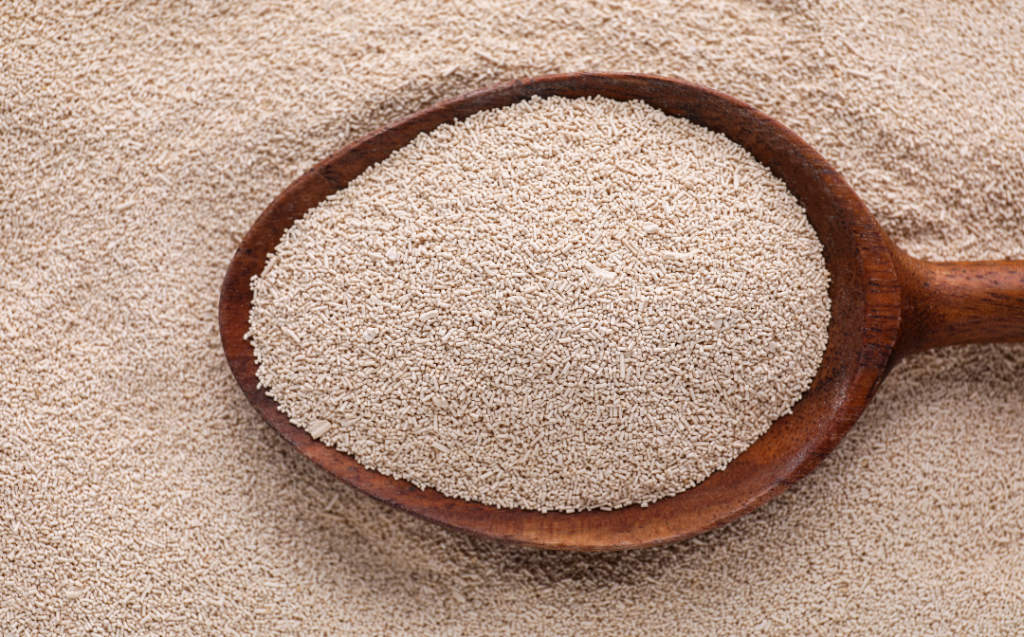
Types and examples of fillers
Various fillers are used in the food industry, whereby the choice depends heavily on the product and the desired properties. As mentioned above, fillers can be divided into three categories: Natural, nature-identical and synthetic materials. Here are some examples of these different filler materials and what they are used for:
Natural fillers
- Locust bean gum (E410)Is obtained from the seeds of the carob tree. Locust bean gum serves as a natural thickening and gelling agent. It is often used in the production of gluten-free baked goods, in desserts, dairy products such as yoghurt and ice cream as well as in sauces and soups.
- Guar gum (E412): A thickening agent and stabiliser obtained from the seeds of the guar bean. It is often used in gluten-free baked goods, dairy products and sauces.
- Gum arabic (E414): Is a natural resin obtained from the hardened sap of various acacia species. It is used in the food industry as an emulsifier or stabiliser to improve and maintain the consistency of liquid products.
- Konjac (E 425)Is obtained from the root of the konjac plant. In the food industry, konjac is used as a thickening and gelling agent. It is particularly known for its ability to bind many times its own weight in water, making it an ideal ingredient for products such as gelatine substitutes, pasta, and as a stabiliser in various gluten-free or low-calorie foods.
- Pectin (E 440)Pectin is a naturally occurring polysaccharide that is mainly obtained from the cell walls of fruit. Apples and citrus fruits are particularly rich sources of pectin. It is widely used as a gelling agent, especially in the production of jams, jellies and fruit preparations. It is also used in desserts, sweets, juices and as a stabiliser in dairy products.
- Cellulose (E460): A vegetable fibre extracted from cotton or other plant sources. In powdered form, cellulose is used to prevent lumps from forming in grated cheese or is used as a thickening agent in baked goods.
- Maize starch (E1404 to E1450): A type of carbohydrate that is extracted directly from the endosperm of the maize kernel without changing its chemical structure. Cornflour is often used as a thickening agent to improve the consistency of soups and sauces.
Nature-identical fillers
- Ascorbic acid (vitamin C) (E300): Although vitamin C occurs naturally in citrus fruits, the form used as a filler or antioxidant is often produced in a laboratory to ensure an exact chemical match with its natural counterpart.
- Citric acid (E330): Naturally occurring in citrus fruits, it is often used in the food industry as a preservative or acidifier. However, the industrially used citric acid is produced by microbial fermentation.
- Beta-carotene (E160a): While beta-carotene occurs naturally in carrots and other vegetables, the nature-identical form is used synthetically for constant colouring in foods such as margarine and snacks.
Synthetic fillers
- Polydextrose (E1200): A synthetically produced polysaccharide used as a bulking agent in sugar-free foods to add sweetness and texture without adding many calories.
- Maltodextrin (E1400): Although it is derived from natural starches, maltodextrin undergoes an extensive industrial process that effectively makes it a synthetic product. It is used as a thickening agent or to improve shelf life in numerous foods.
- Sodium carboxymethylcellulose (CMC) (E466): A synthetic gum that is used as a thickener, emulsifier and stabiliser in various foods, from ice cream to baked goods.
Some names sound less "chemical" than their E numbers, which is why you often find the name on the packaging in these cases. Others sound so chemical that even the E number no longer bothers you. E-numbers beginning with 400, 500 and 1200 usually stand for fillers.
Some of these substances, such as pectin from apples, are known to be healthy. Konjac is even valued in vegan cuisine. But it makes a big difference whether you ingest these substances naturally or find them in chemically processed form in ready-made products.
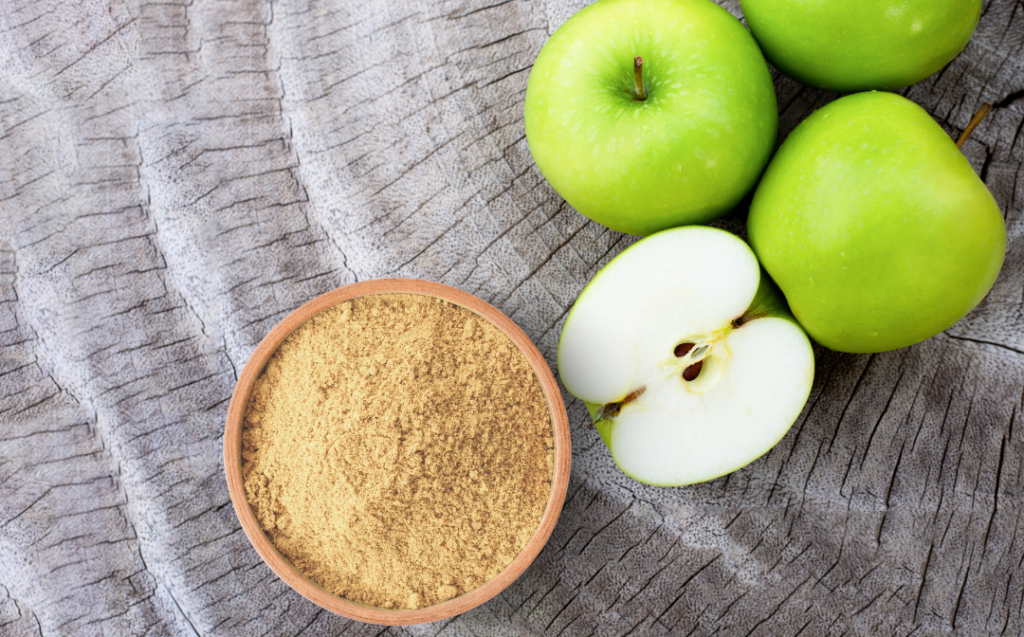
Are fillers harmful to health?
The health risk of fillers in food depends heavily on the type of filler, the amount consumed and the individual health of the consumer. In general, food authorities such as the European Food Safety Authority (EFSA) and the US Food and Drug Administration (FDA) classify fillers as safe as long as they are used in the authorised amounts. Nevertheless, there are discussions and concerns about certain fillers:
- Allergies and intolerancesSome fillers can cause allergic reactions or intolerances. For example, people with coeliac disease or gluten intolerance may react to wheat starch, which is used as a filler in some products.
- Digestive problemsSome fillers, especially certain types of fibre such as polydextrose, can cause digestive problems such as flatulence, abdominal pain or diarrhoea if consumed in excess.
- Artificial fillersWhile many fillers are considered safe, some consumers prefer natural ingredients over synthetic or highly processed additives. There is debate about whether certain artificial fillers could pose long-term health risks, although most of them are considered safe by regulators.
- Nutrient intakeThe use of fillers can reduce the calorie content of a product, which can be beneficial, but can also result in foods being less nutritious. Excessive consumption of products with a high filler content can potentially lead to an insufficient intake of important nutrients.
- Specific health concernsSome fillers have been linked to specific health concerns. Maltodextrin, for example, has a high glycaemic index, which means that it can quickly raise blood sugar levels. Not harmful to health in moderate amounts. But for people with diabetes or insulin resistance, too much can be problematic.
How do fillers influence price and quality?
Fillers make food cheap. And in a double sense: in terms of price and quality. By using fillers, manufacturers can use less of the more expensive main ingredients without us realising it. In other words, they stretch or "dilute" the product. The result is a cheese that consists not only of high-quality cheese, but also of these additives. This leads to what is known as deceptive packaging, which reduces the quality of the food. It's a balancing act for the industry: enough of the good stuff to preserve flavour and quality, but enough of the cheap fillers to keep costs down. As a result, customers get used to low prices, which in turn puts pressure on those manufacturers who still avoid such fillers and only offer real food. When shopping, you therefore have to be particularly vigilant to discover products without such additives - and this applies not only to conventional retailers, but also to organic markets.
What fillers are found in organic vegetable stock?
Many people immediately think of high-quality, natural ingredients when they think of organic vegetable stock. Ideally, it should be exactly the same. However, fillers are also used here, albeit in a more natural form:
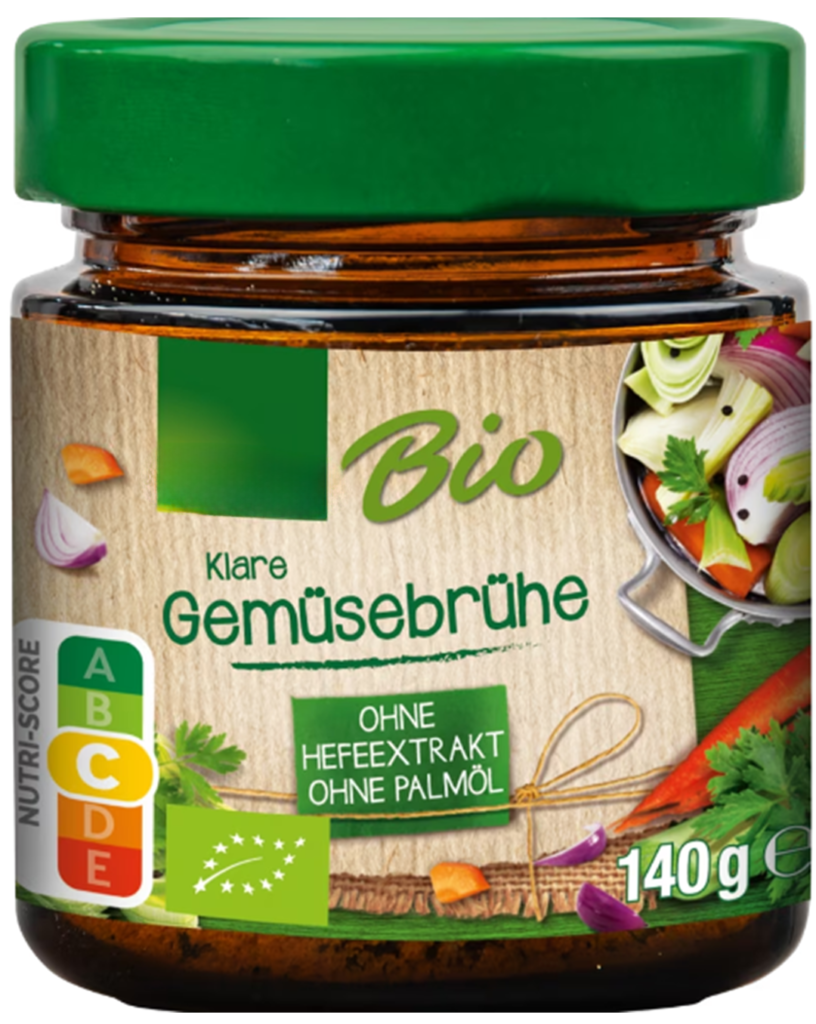
Ingredients: iodised table salt (table salt, potassium iodide), Sugar*, 5.8% onions*, 5.5% carrots*, Strength*, Maltodextrin*, 2.6% leek*, sunflower oil*, herbs*, 0.5% CELERY*, spices*.
*From certified organic farming. The product may contain traces of EGG, GLUTEN and MILK.
Note: This vegetable stock uses a greater quantity and variety of fillers and additives such as sugar, starch and maltodextrin, which are often used in the food industry to improve flavour, texture or shelf life, but do not increase the nutritional value.
Ingredients: Sea salt, Maize starch*, Glucose syrup*, Palm oil*, 2.8 % Onions*, Yeast extract*, 2.3 % carrots*, 1.8 % CELERY*, parsley*, leek*, turmeric*, mace*, lovage leaves*, CELERY leaves*, pepper*.
*from certified organic farming
Note: This vegetable broth also contains fillers such as corn starch and glucose syrup as well as palm oil, which can be viewed critically for environmental and nutritional reasons. However, the broth offers a slightly wider range of vegetables and herbs compared to the first.
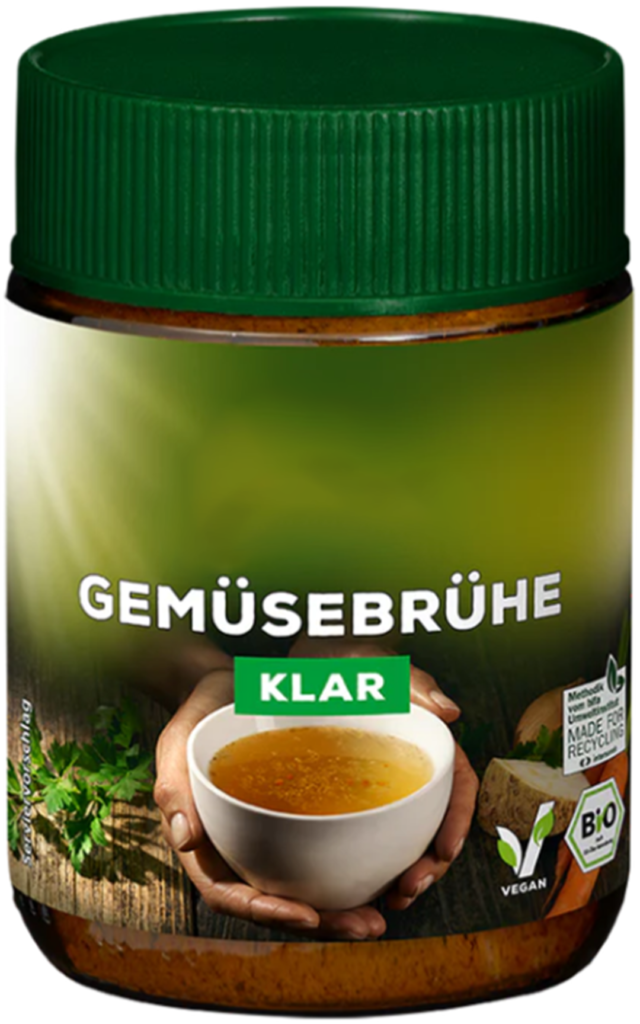
The better vegetable stock
A vegetable broth without hide-and-seek: You won't find any fillers, additives or flavour enhancers in Wacker vegetable stock. At Wacker, we attach great importance to naturalness and a high nutritional value, which is why we only use high-quality and natural organic ingredients in our vegetable stock - just as a good organic vegetable stock should be. The very high vegetable content and the simplicity of the ingredients list reflect a quality that focuses on the essentials:
Ingredients: 50 % vegetables* in variable proportions by weight (onions*, carrots*), rock salt, herbs* (lovage*, parsley*, chives*), turmeric*.
* from organic farming

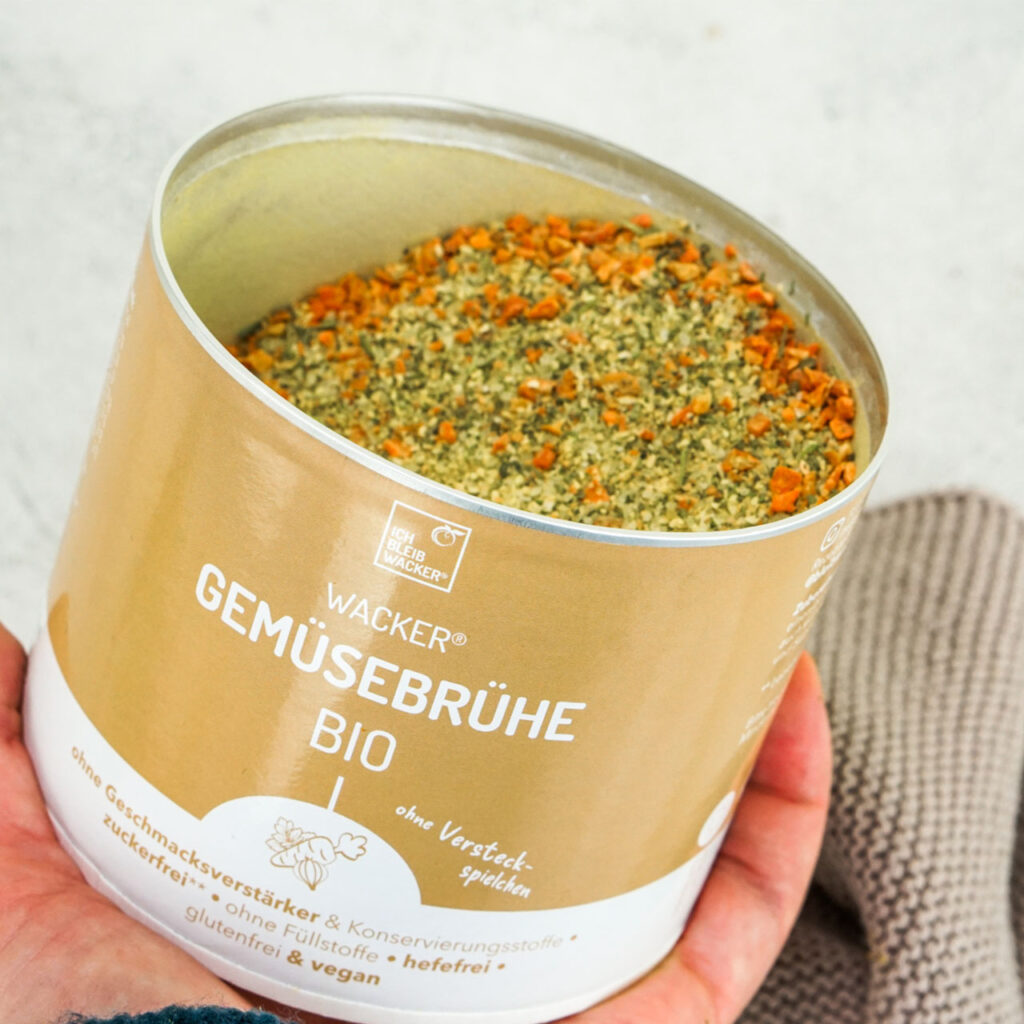
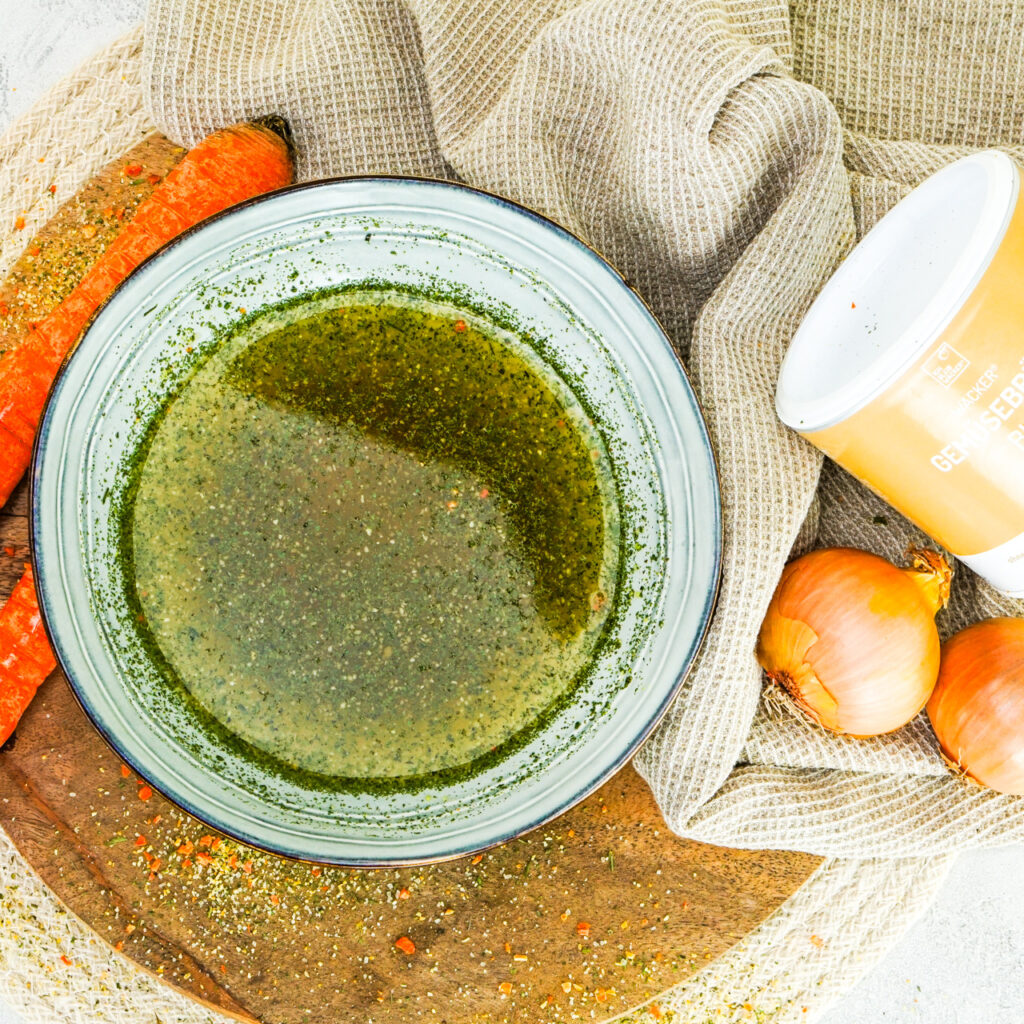
Order Wacker organic vegetable stock now
Conclusion: What does this mean for you?
First of all, don't panic. Not all fillers are bad. The key is to be informed. Look at the ingredient lists before you buy. Products with a short, understandable ingredient list are often a good choice.
Fillers can be found everywhere in the food industry. They make food more affordable, but can also affect the quality. By knowing what's in your food, you can decide which products meet your quality standards and which you'd rather leave on the shelf. By choosing products that avoid unnecessary fillers, you not only support your health, but also manufacturers who rely on genuine, unadulterated ingredients.
So the next time you're browsing the supermarket shelves, take a little more time to study the ingredients lists. It could not only help you save money, but also contribute to a more conscious and healthier lifestyle. Because at the end of the day, it's you who decides what ends up on your plate.



